The uni's burning via Internet
Observations on the changing nature of protest
The rapid expansion of the student protests across the German-speaking space was largely a result of Web 2.0 and the different networking possibilities it offers. Refuting derogatory references to a “facebook rebellion” as the tired expression of a ’68 fixation and tackling the charge that the virtual sense of “being there” undermines active participation, Jana Herwig, Max Kossatz and Viola Mark examine what the student protests reveal about changing the face of political activism in the era of Web 2.0.
The spectrum of the possibilities of web communication has diversified yet further in recent years in the direction of dynamic content and user participation. Alongside e-mail, search engines, and websites, the so- called Web 2.0 now offers blogs, Wikis, social networking sites, microblogs and media-sharing for photos, documents, audio and video material. Internet access itself has gone mobile.
What does that mean for protests in and with these media? What structural differences do these protests reveal with respect to earlier movements and how, in concrete terms, should the role of a platform such as Twitter be interpreted? Does the presence of new technologies serve to strengthen protest movements and those who participate in them, or in fact weaken them?
Empowerment through Web 2.0
The following argument shares Nicola Döring’s assumption that the Internet has improved the potential for the development of underprivileged groups and individuals.1 Notable in this context is the concept of empowerment, which the psychologist Julian Rappaport2 describes as a development at the end of which a person or community feels empowered to shape and determine their life and circumstances. This can mean different things, but what is important is the feeling of self-efficacy – the sense that one can exert an influence on one’s surroundings – and an internal locus of control.3 If the current university protests are understood as a process of empowerment, then they arose from a threat to the living and studying environment that students expected or had grown accustomed to. This threat led to feelings of powerlessness, even helplessness. Many students may have sensed this much earlier – as a result of “knockout” exams, the stricter curricularization and the reduced freedom of choice introduced by Bologna, or a lack of job prospects. Nevertheless, it took time to find appropriate means and forms of expression for their discontent and to form a movement.
Mobilization, involvement and the development of strategies to (re)gain control can be established particularly effectively through interaction with others and with the support of groups with similar interests. The expansion of the protest thus owes itself in no small measure to the different networking possibilities offered by the Web, which allows people and groups with similar interests to meet more quickly and easily. Following the initial occupation of the Audimax (the main auditorium of the University of Vienna – ed.), like-minded people were able to get in touch more quickly and mobilize each other to join the protest. Working groups were, among other means, organized on the Internet; similarly, anyone could find out on their computer what was on the daily agenda and what was being decided in the plenary discussion. It was easy to “be there”.
Social media: Deserving of a Nobel prize?
For all the possibilities that are being created and exploited on the Web, the university protests in 2009/10 were no more a “Facebook rebellion” – either exclusively or causally – than the protests in Iran following the 2009 elections were a “Twitter revolution”. The more extensively a medium is already integrated into (societal or individual) processes of communication and perception, the less visible are the ways in which it communicates information. No one talks about the role of the telephone in the administrative apparatus of the state – yet the role of new forms of communication like the “Social Web” is often overstated. A former deputy national security advisor under the Bush administration, for example, declared that Twitter should be awarded the Nobel Peace Prize.4 Not only does this do a disservice to the individuals who use this platform, but also to those who have no access to the Internet, or indeed who want none.
A similar focus on the role of Web 2.0 and “social media” could be seen in the reporting of the university protests: the difference here was that the emphasis served to discredit the protesters more than to praise the technology they used. For instance, the leader in Die Presse on 24 October commented:
“‘Student revolutions aren’t what they used to be’ is what the old comrades will say who in the Sixties wanted to make the world in general, and universities in particular, a better place. The mix of flashmob party and voodoo ideology in the Audimax of Vienna University, which you could follow in real time on the Internet, leaves an ambivalent impression.”5
It is still the case that all protesters are judged by the idealized benchmark of the ’68ers, often solely in order to point out differences. Mouse click is thus compared to street fighting, “recreational strikes” to social critique, hedonism to political motivation – ultimately doing justice to none. Many of these misunderstandings can be explained by the way in which the respective movements were structured, internally and externally. The iconography of the ’68ers was marked by spectacular one-off protests and provocative displays – from the performances of the Vienna activists, to the naked photographs of the Kommune 1, to the sit-in demonstrations. In the latest university protests, things have been turned inside out – partly consciously, in the name of transparency (setting up and maintaining the live web-stream from the Audimax) and partly as a side effect of the relatively widespread use among students of platforms such as Facebook, StudiVZ and Twitter. The result is that the material from which conclusions can be drawn about the occupiers is not only considerably broader, but also extends further into the trivia of participants’ daily lives, beyond the “performance” of the protest. After all, it seems improbable that partying after the day’s protest was first conceived of in the Audimax – it is just that in ’68, only those who were actually there could share in the post-protest beer. Today’s journalists, by contrast – even, or especially, those suspicious of “flashmob voodoo” – do not necessarily have to be at the actual site of an occupation. Thanks to “lifecasting” (the constant transmission of events through the course of the day) they have been able to follow the debates, look up pictures on Flickr and Twitter, and even get hold of participants to interview.
Web activism: competition or integration?
A question that has been fiercely debated among the protesters was whether the protests have been undermined by the virtual element. If everything can be experienced in real time on unsereuni.at, wouldn’t sympathizers just stay at home, without coming into the Audimax? Does this mean that the Internet weakens the potential for protest? By showing their solidarity on Facebook, are protesters neglecting to express their dissatisfaction in public? Marion Hamm diagnoses a more interactive kind of relationship, arguing that the British “no borders” movement showed that:
“The idea that filtering through the media would replace street protest [was] off the mark, both for those who were pessimistic about the technology and those who were euphoric. Instead, what has developed is a practice whereby the use of the media and medial self-representation, became integral parts of the local protests on the streets.”6
For one thing, the Internet and the Web have made possible a previously inconceivable degree of mobilization. Far more people can be informed, with far less effort, about what is planned than would be the case via word of mouth or through leafleting. On the other hand action “on the street” can be prepared and later evaluated, documented and discussed. The easy accessibility of information, as well as media coverage of the protests on the Web and through social networking sites, has also aided the spread of information beyond those groups closest to the protests (the student community, student representations , student unions). (Mobile) phones speed up person-to-person communication – mailing lists can reach a lot of people and generally reflect a collective interest. Publishing notices online makes content accessible to people who are not in one’s own address book: not only “strong”, but also “weak” ties – for instance “friends” on Facebook one hardly knows or rarely sees – become visible on social networks. Statistics on one’s wider personal sphere (“5 friends have become fans of The Audimax Occupation in Vienna – Die Uni brennt! / The uni’s burning!”) give the slogan “the personal is the political” a new twist beyond party political recruitment attempts. What helps journalists helps others: the first points of contact to a protest come from reading messages such as these, from using the “Hashtags” on Twitter (see below), from joining Facebook groups, and much else besides – a cascade of new media-based interaction which in many cases sooner or later brought people into the spaces being occupied.
The decision to join a protest follows a variety of inter- and intrapersonal influences. According to Stürmer and Simon,7 there are four steps in becoming an active member of a protest: first, sympathy towards the cause of the protest must exist; second, calls to mobilize must reach the person in question; third, the person’s motivation to participate must be developed; and fourth, any difficulties that might prevent participation must be removed. In the protests of 2009 and 2010, the Internet probably enhanced this process, particularly the second and third stages. Many people found themselves motivated very quickly through being able to participate in the events online. Online participation reduces the costs of taking part, rapidly creates a collective identity and fosters the emergence of a community.8 In other words, following the events online can also create the feeling of belonging to a community. Discussion forums and the visual sense of “being there” can create an emotional connection. “Following” enables social relationships to be formed virtually and is instrumental in shaping them.
“Permanently Beta” and collective organization in real time
It was not only the occupants of the Audimax at any one time that fluctuated – the contents of the protest changed and only gradually became something organized. On the third day of the occupation, the plenary meeting at 12.30 p.m. was scheduled to discuss the question: “What has been started by the occupation? How should it proceed? What do we what want to achieve?”9 At the beginning of the protest the main concern was to voice discontent about educational policy, while a programme emerged only later – something that was criticized from outside and also at times from inside. Yet from the perspective of web-based forms of organization, this way of going about things seems to make sense. Gina Neff and David Stark call this organizational state of flux “Permanently Beta”:
“The process of continual technological change necessitates a responsiveness to change through openness in organizational form, adaptability by employees, and, in the most positive form of permanently beta, broad participation in design.”10
A form of community organization according to the “permanently beta” principle would therefore be one that reacts on every level to the participants, one that they are able to adapt and as far as possible have a role in shaping. This was the case for the protest movement in the Audimax: people chairing the discussion in the auditorium rotated daily, as did the press spokespeople, so that no hierarchies could be created by force of habit. The use of web tools also contributed to organization: information was passed on via e-mail, the Web and social media, and the themes and outcomes of the working groups and general meetings were documented on the “Unibrennt” Wiki. Wikis work not only because many people contribute new content, but also because many people can check and quickly correct any errors that have crept in, and refine information incrementally. Pierre Lévy considers the possibility of collective intelligence supported by technology at a utopian level:
“The group relies on political technologies of transcendence when it becomes too large for individuals to know one another by name or comprehend in real time what they are doing as a group.”11
The use of “Hashtags” on Twitter, for example, enables this with astonishing effectiveness. The social network on Twitter is formed, on one hand, by subscriptions – whether one-sided or reciprocal – to others’ updates. On the other hand, “Hashtags” – the combination of the “#” sign with another sequence of characters, e.g. “#unibrennt” or “#unsereuni” – can help to filter the current news of all Twitter users. This not only enables collective organization around topics and concerns without having to know contributors personally in advance, but also creates a basis for the expression and the understanding of the variety of positions. According to Lévy, violence or crisis situations could become a thing of the past in these scenarios: “Able to reorganize itself in real time, minimizing delays, deadlines, and friction, the molecular group evolves at room temperature, without sudden change.”12
#unibrennt and Twitter
In the protests at the Academy of Fine Arts in Vienna, the Internet and Web 2.0 played an important role right from the start. Without these tools, too much time would have passed and the whole “#unibrennt” movement might have taken on different forms. Twitter made it possible to reach important disseminators of information (bloggers, journalists, students) and thus a large number of people, as the following analysis shows.
Between the afternoon of 23 October to midnight on 31 December 2009, a total of 95 743 “tweets” (individual Twitter messages of a maximum length of 140 characters) containing at least one of the terms “unibrennt” or “unsereuni” (mostly as a “hashtag”) were sent from 8898 different Twitter accounts. Despite repeated attempts to change it, the first tag to be introduced – “unibrennt” – won out over “unsereuni”, particularly in Germany, with 74 144 to 47 911 mentions respectively. Both tags were often used together (see Fig.1):
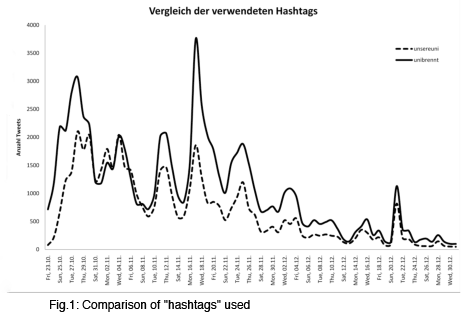
Interesting to note is the distribution of 95 743 tweets over the almost 9000 accounts. 7541 Twitter accounts (out of 8898, or 84.7%) tweeted fewer than ten times over the period about #unibrennt (a total of 18 760 tweets, or 19.6% of the total). On the other hand, 155 accounts (1.7% of the total) contributed at least 100 times each on the topic #unibrennt (42,591 tweets, or 44.5%). Again, we can see the “20/80 rule of thumb”: that 20% of accounts are responsible for 80% of the content (a typical percentage on Web 2.0 platforms).
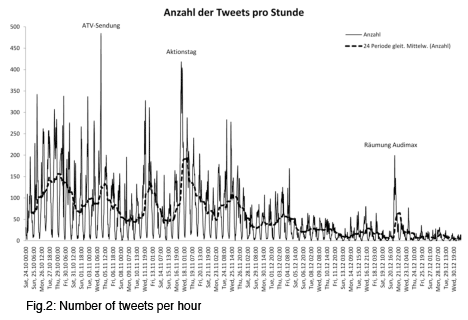
Important events in the movement can be clearly observed by looking at the number of tweets posted throughout the period (see Fig.2). This clearly reveals the predominance of the use of Twitter as a disseminator of information (what is happening at the moment where?). It is also clear that mass media such as television, if used cleverly (for example the broadcast from the Audimax on Austrian private channel ATV), can spark interest online and profit from that interest. Also clear is that after the initial euphoria, interest tailed off substantially – as early as the beginning of December. The evacuation of the Audimax in Vienna aroused nothing like the same level of interest that existed at the start of the protests.
As for the places people were tweeting from, one can observe over the course of the period an expansion across the entire German-speaking area, starting from Vienna as the “point of ignition” of the movement. The illustration below, a still from an animation,13 shows the spatial spread of Twitter updates:
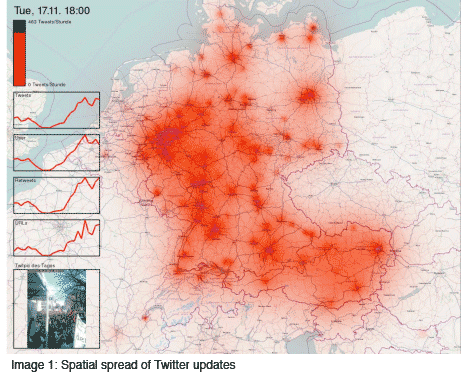
This moment in time (17 November, 6pm) shows the maximum extent of tweeting. After the “action day”, the appearance of tweets did not immediately decline, but became more concentrated on the occupied universities.
A total of 38 589 tweets (40.3%) included a link to a website. Most frequently, these were the homepage of the protest, the live stream or links to articles in the press about the university occupations. In order to provide followers with a visual impression of what was going on, local events were often posted on Twitpic.com, a service enabling anyone to upload pictures from a computer or mobile phone and then to circulate it on Twitter. Between 23 October and 31 December 2009 a total of 2428 photos were circulated, which were viewed well over 150 000 times. In Fig.3 the chronological posting of photos on Twitpic can be seen (the criterion being when each photo was posted on Twitter).
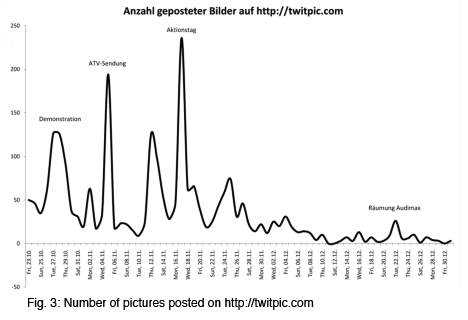
The “tag cloud” below of all tweets in the period shows the content being tweeted about, minus the tags “unsereuni”, “unibrennt” and “audimax” (otherwise the scale would make it much harder to read the other words). In a tag (catchword) cloud, the size of a term is shown in proportion to the frequency of its use.
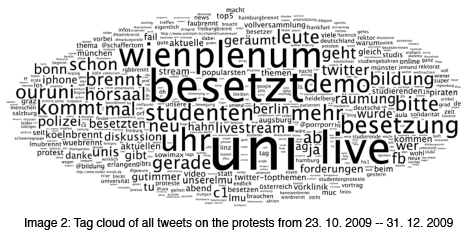
What some have seen as the protest’s failure to formulate demands is very well reflected in the posts on Twitter: terms such as “proper funding” or “quotas regulation” are not visible in the tag cloud. What needs to be remembered, however, is that messages were posted not only by protesters but also by observers and opponents. This reveals the difficulty of broadcasting a concern (in the form of a concrete appeal) in a targeted fashion via a medium used by heterogeneous groups. The character limit on Twitter plays a part too – perhaps the old advertising rule “No more than two messages per poster” still applies in Web 2.0.
The occupation of the Audimax, including the networking possibilities it offered and the visualization of the protest’s sphere of influence, can be understood as a perception of stabilization and integration, of activity and self-fulfilment. However this perception was deeply undermined by the evacuation of the Audimax. According to the concept of empowerment, at the end of the process one is still in a state in which one is convinced of being able to shape one’s life and surroundings according to one’s own imagination – albeit in the full awareness that this is a process that may well take time. At the time of writing – three months after the end of the occupation – there were still 100 Twitter updates per hour on the topic. When asked about what they would take from the protests, people involved all spoke of a feeling of being able to make a difference.14 They could thus be described as “empowered”, a feeling contributed to, not least, by the Internet and its various forms and applications.
See Nicola Döring, Sozialpsychologie des Internet -- Die Bedeutung des Internet für Kommunikationsprozesse, Identitäten, soziale Beziehungen und Gruppen, Göttingen 2003.
Julian Rappaport, "Studies in Empowerment: Introduction to the issue", in: Julian Rappaport, C. Swift and Robert Hess (eds), Studies in Empowerment: Steps towards Understanding and Action, Bighamton: The Haworth Press 1984.
Elisabeth Hinterberger, Psychologisches Empowerment im Zusammenhang mit Gesundheitsbezogenen Inhalten im Internet. Eine Offline-Studie über das Potential des Internet in der Empowermententwicklung, Wien: Universität Wien 2008, 13.
See e.g.: www.techcrunch.com
Michael Fleischhacker, "Logik statt Twitter", in: Die Presse 24.10.2009.
Marion Hamm, "Proteste im hybriden Kommunikationsraum. Zur Mediennutzung sozialer Bewegungen", in: Forschungsjournal Neue sozialer Bewegungen 19(2) 2006, 77-90, here 78.
Stefan Stürmer and Bernd Simon, "Pathways to collective protest: Calculation, identification or emotion? A critical analysis of the role of group-based anger in social movement participation", in Journal of Social Issues 65(4) 2009, 681-705, here 682.
See R. Kelly Garrett, "Protest in information society: A review of social movements and new ICTs", in Information, Communication and Society, 9(2) 2006, 202-114.
Gina Neff and David Stark, "Permanently beta: Responsive organization in the Internet era", inISERP Working Paper 2002, 5.
Pierre Lévy, Collective Intelligence. Mankind's Emerging World in Cyberspace, Cambridge MA: Perseus 1997, 52.
Ibid. 53.
See Stefan Heissenberger, "Besetzung, Ritual und Raum. Eine ethnologische Annäherung an die Proteste im Wiener Audimax", in: Stefan Heissenberger, Viola Mark, Susanne Schramm, Peter Sniesko, Rahel Sophia Süß (eds), Uni Brennt. Grundsätzliches, Kritisches, Atmospherisches, Wien-Berlin: Verlag Turia + Kant 2010.
Published 1 July 2010
Original in German
Translated by
Saul Lipetz
First published by Stefan Heissenberger, Viola Mark, Susanne Schramm, Peter Sniesko, Rahel Sophia Süß, "Uni Brennt. Grundsätzliches, Kritisches, Atmospherisches", Wien-Berlin: Verlag Turia + Kant 2010. (German version)
© Jana Herwig, Max Kossatz, Viola Mark / Eurozine
PDF/PRINTNewsletter
Subscribe to know what’s worth thinking about.

